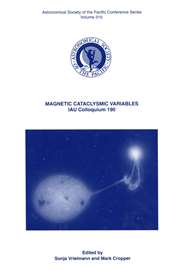No CrossRef data available.
Article contents
A Comparative Study of Lithium Abundances, Radial Velocities, and Emission Lines in Pre-Main Sequence Visual Binaries
Published online by Cambridge University Press: 12 April 2016
Abstract
High resolution (R ~ 20000) spectroscopic observations of visual pairs of T Tauri stars (TTS) in the spectral range 655-675 nm, and 385-405 nm for some systems, are reported. Good seeing allows us to resolve pairs with minimum angular separation of ~ 2″. The radial velocities, overall spectral properties and detection of the Li I line are used to decide whether the components of the binaries are likely to be gravitationally bounded. In this paper we present first results on a subset of our sample: 3 visual companions are not TTS, namely DL Tau/c, GG Tau/c(SW) and NTTS 45251+3016/c. The star GG Tau/c(S) is confirmed as a T Tauri star. The system UZ Tau is probably composed of at least 4 components. The star 1E0255.3+2018 (Fleming et al. 1989), previously thought to be single, is found to be a close visual binary. Finally, lithium abundances for the PMS components of 6 binaries are presented and their consistency with theoretical expectations is briefly discussed.
Information
- Type
- Pre-Main Sequence & Young Binaries
- Information
- Copyright
- Copyright © Astronomical Society of the Pacific 1992

